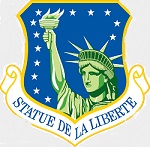Hobby Master HA4539 USAF Boeing F-15E Strike Eagle Multi-Role Fighter - 92-0364, "Liberator", 48th Fighter Wing, RAF Lakenheath, England, 2022 [Anniversary Scheme] (1:72 Scale)
"Obsolete weapons do not deter."
- British Prime Minister Margaret Thatcher
 The McDonnell Douglas (now Boeing) F-15E Strike Eagle is an all-weather multirole fighter, derived from the McDonnell Douglas F-15 Eagle. The F-15E was designed in the 1980s for long-range, high speed interdiction without relying on escort or electronic warfare aircraft. United States Air Force (USAF) F-15E Strike Eagles can be distinguished from other U.S. Eagle variants by darker camouflage and conformal fuel tanks mounted along the engine intakes.
The McDonnell Douglas (now Boeing) F-15E Strike Eagle is an all-weather multirole fighter, derived from the McDonnell Douglas F-15 Eagle. The F-15E was designed in the 1980s for long-range, high speed interdiction without relying on escort or electronic warfare aircraft. United States Air Force (USAF) F-15E Strike Eagles can be distinguished from other U.S. Eagle variants by darker camouflage and conformal fuel tanks mounted along the engine intakes.
The Strike Eagle has been deployed in Operation Desert Storm, Operation Allied Force, Operation Enduring Freedom, and Operation Odyssey Dawn carrying out deep strikes against high-value targets, combat air patrols, and providing close air support for coalition troops. It has also seen action in later conflicts and has been exported to several countries.
The F-15E will be upgraded with the Raytheon APG-82 Active Electronically Scanned Array (AESA) radar after 2007, and the first test radar was delivered to Boeing in 2010. It combines the processor of the APG-79 used on the F/A-18E/F Super Hornet with the antenna of the APG-63(V)3 AESA being fitted on the F-15C. The new radar upgrade is to be part of the F-15E Radar Modernization Program. The new radar was named APG-63(V)4 until it received the APG-82 designation in 2009. The RMP also includes a wideband radome (to allow the AESA to operate on more radar frequencies), and improvements to the environment control and electronic warfare systems.
While some of the F-15C/Ds have been replaced by the F-22 Raptor, there is no slated replacement for the F-15E in its primary "deep strike" mission profile. The Strike Eagle is a more recent variant of the F-15, and has a sturdier airframe rated for twice the lifetime of earlier variants. The F-15Es are expected to remain in service past 2025. The USAF has pursued the Next-Generation Bomber, a medium bomber concept which could take over the Strike Eagle's "deep strike" profile. The F-35A Lightning II is projected to eventually replace many other attack aircraft such as the F-16 Fighting Falcon and A-10 Thunderbolt II, and may also take over much of the F-15E's role; however, the F-15E has better combat range under payload.
Pictured here is a stunning 1:72 scale diecast replica of a USAF Boeing F-15E Strike Eagle multi-role fighter that was attached to the 48th Fighter Wing then deployed to RAF Lakenheath, England, during 2022.
Now in stock!
Dimensions:
Wingspan: 7-inches
Length: 10-1/2-inches
Release Date: October 2024
 Historical Account: "The Panthers" - The 49th Fighter Training Squadron is part of the 14th Flying Training Wing based at Columbus Air Force Base, Mississippi. It operates T-38 Talon aircraft conducting flight training.
Historical Account: "The Panthers" - The 49th Fighter Training Squadron is part of the 14th Flying Training Wing based at Columbus Air Force Base, Mississippi. It operates T-38 Talon aircraft conducting flight training.
The squadron was first activated as the 49th Pursuit Squadron in 1941 during the expansion of the United States military that preceded World War II. Immediately after the attack on Pearl Harbor, the squadron flew air defense patrols off the southern Pacific coast. In 1942, it was re-designated the 49th Fighter Squadron and deployed to England, but a few months later the squadron moved to the Mediterranean Theater of Operations. The squadron earned a Distinguished Unit Citation in 1944 and was inactivated in 1945.
The squadron was activated again at Dow Field, Maine as one of the first units of Air Defense Command (ADC). It converted to Republic F-84 Thunderjets, being one of the first squadrons to do so. The squadron was inactivated in 1949.
In 1952, the squadron, now designated the 49th Fighter-Interceptor Squadron, was activated to replace an Air National Guard squadron that was being released from active duty at Dow. For the next thirty-five years the unit carried out the air defense mission at Dow, Hanscom Field, and Griffiss Air Force Base, upgrading its aircraft until equipping with the Convair F-106 Delta Dart, which it flew for almost twenty years. The squadron was the last to fly that plane, inactivating in 1987 as the Air National Guard took over air defense mission.
The unit was reactivated in 1990 as the 49th Flying Training Squadron at Columbus Air Force Base. Mississippi. It conducted the advanced phase of undergraduate pilot training and basic procedures and techniques of fighter employment since then except for a brief period when it was inactive in 1992-1993. In 2003, its name was changed to 49th Fighter Training Squadron to reflect this mission.








